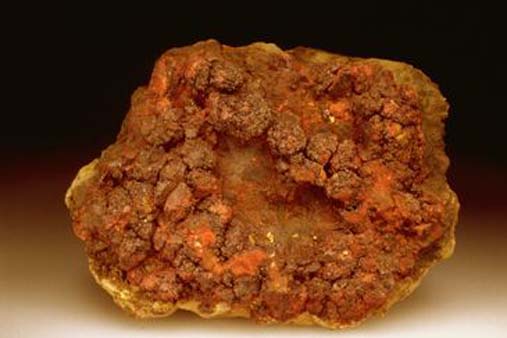About Mercury
 Cinnabar specimen from New Almaden district, Santa Clara County, California. Cinnabar is a mercury sulfide with the chemical formula HgS. It was the main ore of mercury at many California mercury mines. It is characterized by its bright red color. Mercury was recovered by heating the cinnabar and collecting and cooling the mercury vapors that were produced.
Cinnabar specimen from New Almaden district, Santa Clara County, California. Cinnabar is a mercury sulfide with the chemical formula HgS. It was the main ore of mercury at many California mercury mines. It is characterized by its bright red color. Mercury was recovered by heating the cinnabar and collecting and cooling the mercury vapors that were produced.
Mercury is present in the environment as a result of both natural processes and human activities. Natural sources of mercury include volcanoes, hot springs, and natural mercury deposits. Sources related to human activities include coal combustion, waste incineration, certain industrial activities and some mining activities.
When mercury enters an aquatic environment—by erosion, atmospheric deposition or as the result of human activity—it may convert to methyl mercury. Methyl mercury is readily taken up by aquatic organisms and tends to concentrate as it moves up the food chain. This process can result in high mercury concentrations in predatory fish such as striped bass and sharks, and in fish-eating birds and mammals. Mercury is a human neurotoxin, with developing fetuses and small children at highest risk. The principal route of human exposure is through consumption of fish contaminated by mercury.
Historical mining operations played two roles in California environmental mercury issues today. First, between 1846 and 1981, about 100 million kilograms of mercury were produced within the state. Second, gold mining activities that took place between 1848 and the first part of the 20th century depended upon processes that use mercury. Significant quantities of mercury were lost to the environment during both of these activities.
Our Role in Mercury Research, and Related Publications
The California Geological Survey (CGS) participated along with other state and federal government agencies and university research groups in a three-year CALFED research project titled, "An Assessment of Ecological and Human Health Impacts of Mercury in the Bay Delta Watershed." This research project was completed in 2003.
In the project, CGS was responsible for Task 5C1, "Assessment of the Feasibility of Remediation of Mercury Mine Sources in the Cache Creek Watershed." The CGS study investigated mine sites in the Sulphur Creek mining district within the Cache Creek watershed. It identified the mine site materials present at each site and estimated their volumes and mercury contents, and estimated offsite mercury transport. The study also estimated regional mercury background concentrations and contributions from background and other non-mine site mercury sources to the Cache Creek watershed mercury loads.
View and download the report and appendix below:
You may also wish to read the USGS publication "Summary and Synthesis of Mercury Studies in the Cache Creek Watershed, California, 2000-01". It summarizes the principal findings of all the Cache Creek components of the CALFED Bay-Delta Mercury Project.
As mentioned above, CGS' contribution to the CALFED project was limited to mercury mine sources in the Cache Creek watershed. To request other components of the Bay-Delta Mercury Project, send an email to archives@deltacouncil.ca.gov.
Web page by:
California Geological Survey - Mineral Resources Program
